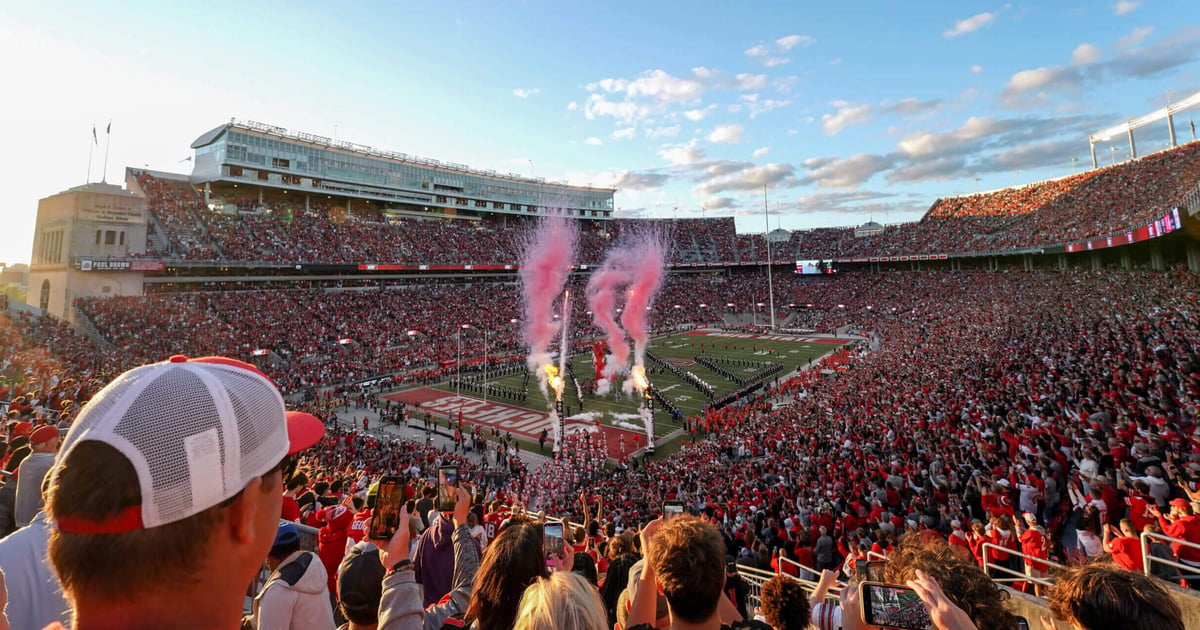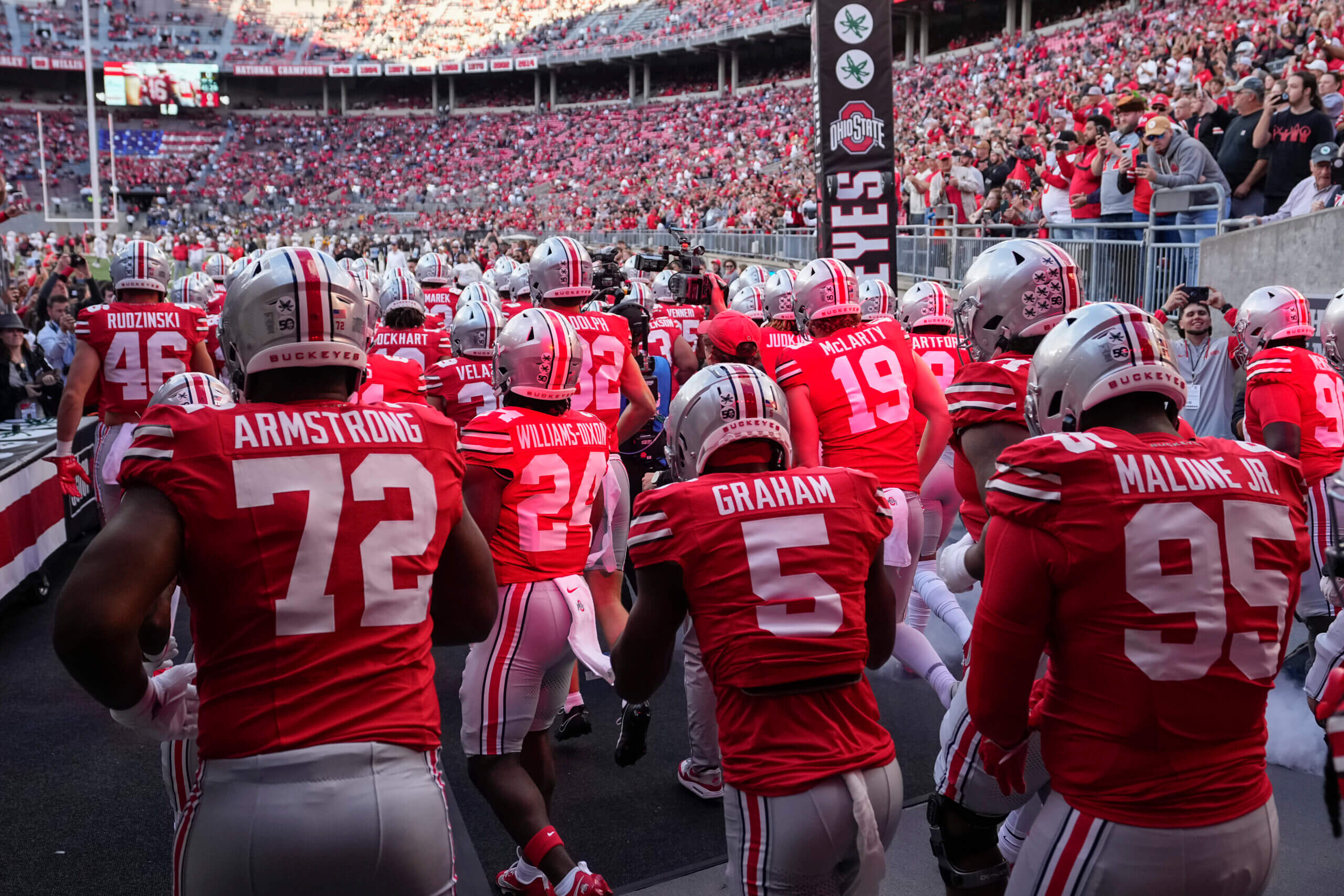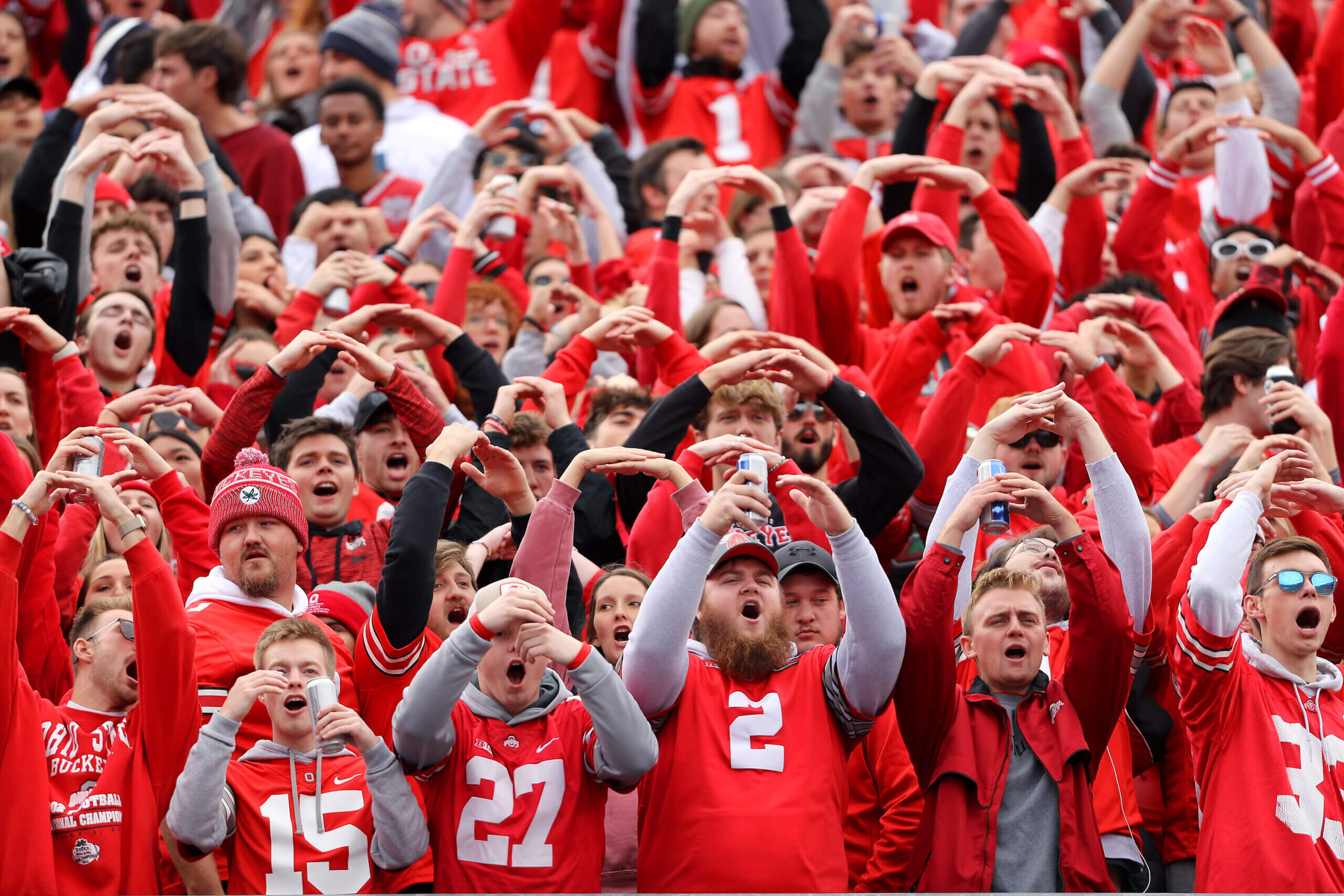
COLUMBUS, Ohio — As the stadium clock approached seven minutes until game time, nobody could be within 25 feet of the flame when Ohio State unveiled its new pyrotechnics machine.
In the press box at the top of Ohio Stadium, Ericka Hoon and Caleb Clark focused on the flame, communicating with staff on the field to make sure nobody was in harm’s way. When cheerleaders took their spots, their flags were too close. They had to be moved.
Then the countdown for Ohio State’s game-day operations staff began. Three. Two. One. The team’s intro video rolled, and the Buckeyes gathered in the tunnel. Smoke began filling up around them, and a crowd of more than 100,000 rose in anticipation.
But just as Ohio State was ready to run out, a few Western Michigan coaches ran by to get to their bench. When the video ended, the Buckeyes ran out and only small flames went off. The large flame stayed dormant, an anticlimactic letdown to those who spent much of the week preparing for the new introduction. It’ll have to wait until this Saturday’s game against Marshall.
Every game provides a new challenge at the fifth-largest football stadium in the world.
A graduate of Ohio State, Hoon has worked in the athletic department since 2007. She’s now the associate athletic director for event management, which means she’s in charge of game-day operations at the 102,780-seat venue alongside people like Clark, the associate athletic director for marketing and live events.

GO DEEPER
Ranking 134 college football teams after Week 3: Texas or Georgia?
The Buckeyes have more than 1,000 concession workers, a few hundred workers in merchandise, around 1,100 ushers, more than a few hundred Ohio State athletics staff and a couple hundred police and safety officers on hand in and around the stadium. Everybody has a job to do to make sure the game goes on safely for the tens of thousands of people in attendance.
The flame not going off may have been disappointing, but it was an operational success. The pyrotechnics supervisor, who doesn’t work for Ohio State, stopping the flame felt like a win to Hoon. If there’s one thing Ohio State’s operations team needs on game day, it’s trust that everybody involved will make the right choice in a tough situation.
“I lean on him and his expertise on what should or shouldn’t happen,” Hoon said. “I’m grateful he saw the situation and knew it wouldn’t be safe. … It shows our relationship with some folks that they know have the power and ability to make a decision — especially when safety is factoring into it.”

Ohio State beat WMU in front of a crowd of 102,665. (Adam Cairns / USA Today)
At 5:09 p.m., 20 minutes before gates opened, Hoon grabbed her radio and a paper off the wall. The paper included the names of every gate manager in the stadium. Fans would soon be entering, and it was time for roll call.
She called down to every manager and asked if they were “gray card ready.”
The gray cards are a way for gate managers to know exactly how many staff and security they are required to have on site before they open their gate. Every gate is different, so if the manager replied to Hoon and said yes, they were good to open their gates at 5:30. If they said no, that meant the team had to fill in who was missing.
Ohio State has been doing roll calls for only a few years. In the past, gate managers would reply by listing everybody who was there and then Hoon would have to do the math and give them the OK to open. The gray cards simplify the process.
“We were having challenges with getting some of our security staff deployed in time,” Hoon said. “Instead of me trying to follow on a sheet, if they can open their gates I give them all a sheet to understand what they have and what is going on.”
Operations work is a lot of logistical coordination. But it’s also about being creative.
Early this season, Ohio State is dealing with changes to the team’s traditional walk to the stadium. The Buckeyes previously stayed across the street at the Blackwell Hotel and had an easy walk alongside coaches’ families. Now, the team is staying at a hotel in downtown Columbus. It must be dropped off by buses near the stadium and walk from there, meaning the operations staff had to work through ways to get families alongside them.
After the walk ends and Ohio State players first take the field for warmups, fans begin to file into the stadium and find their seats. In the depths of the stadium, the “100 minute meeting” begins. It’s held in the visiting team’s press conference room, and it’s crucial to making sure the football game goes off without a problem.
The Sept. 7 meeting, led by Hoon, featured a representative from multiple departments that had a hand in making sure the prime-time game against Western Michigan ran smoothly. There were people from the Big Ten Network, a referee, another member of the referee association, somebody from the NCAA replay committee, a WMU athletics staffer, multiple people from Ohio State’s event staff and more.
After everybody introduced themselves, Hoon ran through a quick list of last-minute plans. She informed everybody that Ohio State would enter the field first and leave first at halftime. Everybody agreed. Even though Ohio State is the home team, no detail can be assumed. The planning is essential to minimize the chances of any on–field altercations.
Hoon then said kickoff could be pushed back 5 minutes if the Maryland–Michigan State game went long.
Communication is the key to putting on a game at Ohio State. Hoon may be the ringleader, but she’s just one person in a large machine that is Ohio State’s athletics operations.
“You can’t do it alone,” she said.
Hoon attributes that atmosphere to former athletic director Gene Smith, who was the first AD Hoon worked for. Smith was known for being personable and trustworthy, which trickled down to the entire department.
“His leadership for so long is empowering people and letting them be the decision-maker,” Hoon said. “You’re the expert in your area, you’re going to know best so make the decision. If you’re willing to live with that, help us understand the why and we will support you. That’s a small piece of empowering people, while still having a good time.”

Ohio Stadium has grown from its original 1922 capacity of 66,210. (Joseph Maiorana / USA Today)
Long before the Ohio Stadium press box fills up with reporters and communication staff, the command post on the far side of the box buzzes.
There are six large screens in the room. One has a live update on tickets, one has an updated weather radar and forecast, one has a live feed of highway traffic and two are focused on cameras around campus.
Those two monitors have multiple internet tabs open, with each tab showing views from 12 to 16 cameras around Ohio Stadium and the surrounding buildings and parking garages. The operations staff can watch traffic, tailgates, parking garages and every entrance of the stadium. They can also zoom in and out and get a live look at anything they want.
If something goes wrong, they can make a quick call to get it addressed.
Just below the TVs, on a few desks along the wall, are four monitors with students in front of them. They are the dispatchers, a key part of the process. Their job is to answer the numerous radios in front of them, take in information and log it, allowing security or other staff to take care of any concerns.
The dispatch process is done in conjunction with the Schottenstein Center basketball arena next door. The arena is less than 20 percent the size but holds far more events than the football stadium, meaning it has an experienced staff. Ohio Stadium utilizes them to help train interns who work football games.
Saturday’s work takes concentration from everybody involved. The ushers around the stadium have radios that go directly to the dispatchers so they can address them with any questions they have. From there, anything that is radioed goes into the system and is labeled as a color. Red means the request was filed, yellow means somebody was dispatched to the problem and green means a worker is on scene.
The questions are wide-ranging. Wheelchair requests were a big part of the job, with operations staff coordinating exactly which gate and seat they needed to go to. At one point before the game, an usher also relayed a question about where a fan could find cotton candy. Twice, there were calls about a child who lost their parent at the game, and the command center was able to help by locating the seats. Each time the parent was found soon after the call came in.
The command center is relatively calm once the game begins. There’s not much stressful yelling going on; in fact, staffers are often joking around. They even have a weekly contest seeing who can guess closest to the actual ticket number each week.
It keeps stress levels relatively low. Even when something goes wrong, there’s a tight-knit feeling, down to the interns in the room helping out.
Hoon wants people to learn, ask questions and find solutions. There were times where she stepped out of the room to take care of something else and others on her staff handled calls like when Western Michigan’s cheerleading bus went the wrong way and had to be directed through traffic to an alternate gate. Or something a little bit larger like reorganizing one of the traffic patterns at halftime as fans were leaving a 35-0 blowout early and the staff didn’t want cars and fans to be crossing the same area.

GO DEEPER
Controversy, mystery and lore: How the Big House at Michigan embodies college football
Many fans still stayed until the end of the 56-0 win. After the game, the operations staff’s job isn’t over. The staff helped people get into the stadium safely, and now they had to get them home, monitoring the flow of traffic out. A change made in the last decade was to turn the lights on at all of the surrounding sports fields so fans had more light when walking back to their cars.
Every week Hoon goes home with a list of things they can improve or make easier for the following week, or sometimes the next season if it’s a big idea. One of those things during Ohio State’s idle week was working on ways to get the pyrotechnics flame off without a hitch this Saturday.
Once crowds have dispersed, the staff splits up and goes to the home and visiting team locker rooms to make sure teams get on the bus and out of the stadium safely. Then they leave the stadium through the rotunda and take a family selfie in front of the new statue of two-time Heisman Trophy winner Archie Griffin.
It’s a ritual to mark the end of another game before a new week comes and they prepare to do it all again.
“That’s the moment when everybody can smile,” Hoon said.
(Top photo: Jason Mowry / Getty Images)